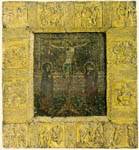|
|
| Portable Icons |
late 13th- early 14th c. Vatopedi Monastery Mosaic on wood, 33 x 29 cm |
|

|
In this mosaic icon of the Crucifixion, Christ is depicted dead upon the cross, his arms outstretched, his body curving and slightly turned towards the right, his head bent. The cross is symmetrically flanked by the figures of the Virgin on the right, lifting her head with controlled grief towards Christ, and St John on the left, sorrowful and introverted in a limp pose reminiscent of figures on ancient grave reliefs. The Virgin wears a brown tunic and a dark blue mantle, John a dark blue tunic and a brownish red himation. They are accompanied by the inscriptions 'Mother of God' and 'St John'. Two angels are shown flying away beneath the arms of the cross. The whole scene is set before the walls of Jerusalem, which is depicted in the background in a purely conventional, decorative manner. The ground of the upper part of the icon is done in silver tesserae, most of which have fallen off, the lower part in green to denote the natural terrain, dotted with sketchy white and dark blue flowers. The haloes are outlined with alternating white, dark blue, and red tesserae, giving a chequered effect. The ground of the haloes must have been similarly rendered, but most of the tesserae have fallen off. The upper part of the icon is framed by a series of multicoloured lozenges, which isolate and emphasise the crucified Christ. The mosaic Crucifixion is framed by a silver cover on which are depicted twelve scenes from the Dodekaorton, separated by narrow ornamental compartments, probably inspired by oriental gold- and silver-work. The cover is contemporary with the icon and dates to the early fourteenth century (Loverdou-Tsigarida 1996, pp. 488-9, fig. 314). The simple format of the Crucifixion, confined to the main participants, with its specific iconographical details, such as Christ's pose, the departing angels, and the walls of Jerusalem, belongs to the iconographical tradition of the eleventh to twelfth century. It did continue into the Palaeologan period, however, as is apparent not only from this icon from Vatopedi, but also from other mosaic and painted icons, such as the Berlin Crucifixion (late 13th c.) and the Crucifixion in the mosaic Dodekaorton in Florence (early 14th c.; Lazarev 1967, figs. 427, 490). As regards technique, this Crucifixion is distinguished by its variety of colour, its decorative tendency, and the use of truly minute multicoloured tesserae of stone, glass, and silver, which the artist handles with exceptional dexterity as he affixes them to a layer of mastic on a wooden panel support. With the exception of Christ's loincloth, the garments are rendered in monochrome and the folds are defined, in an imitation of enamel technique, with hair-fine threads of silver, which give the impression of linear highlights. The face, however, with its pinkish wheaten flesh and 'flickering highlights' in the form of minute dots on the brow and around the eyes and nose, is rendered in a painterly manner with marvellous skill in the details. A similarly painterly technique in the rendering of the clothes and face is seen in the mosaic icon of Christ Emmanuel (late 13th c.), originally from Mount Athos and now in the Historical Museum in Moscow (Bank 1985, no. 258). And a similar halo and frame are seen in the mosaics in the Church of the Porta Panagia in Thessaly, the icon of the Dodekaorton in Florence (early 14th c.), and the mosaic icon of four hierarchs (early 14th c.) in the Hermitage (Weitzmann et al. 1982, p. 165. Lazarev 1967, fig. 490. Bank 1985, no. 259). On the basis of these iconographical, technical, and stylistic details, this writer would date the icon to the late thirteenth or early fourteenth century.
| |
|
Bibliography: Lazarev 1967, p. 285. Grabar 1975, pp. 52-3. Furlan 1979, no. 24, p. 149 (with earlier bibliography). Tsigaridas 1996 (1), pp. 369-72, fig. 314. Loverdou-Tsigarida 1996, pp. 488-9, fig. 314.
| ||
| E.N.T. | ||
| Index of exhibits of Monastery of Vatopedi 13th century |
||
Reference address : https://www.elpenor.org/athos/en/e218ab12.asp